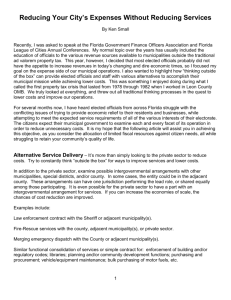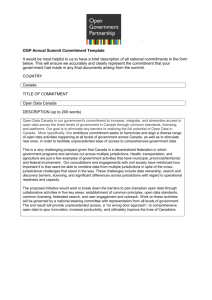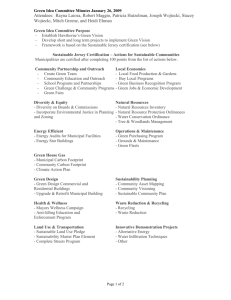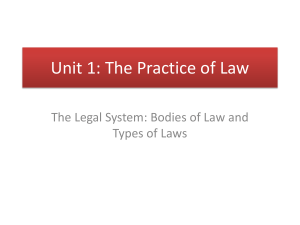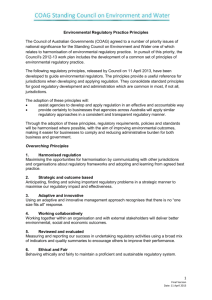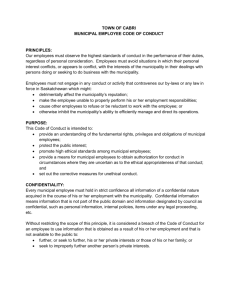30 or More Ways to Reduce Your City`s Expenses, Ken Small
advertisement
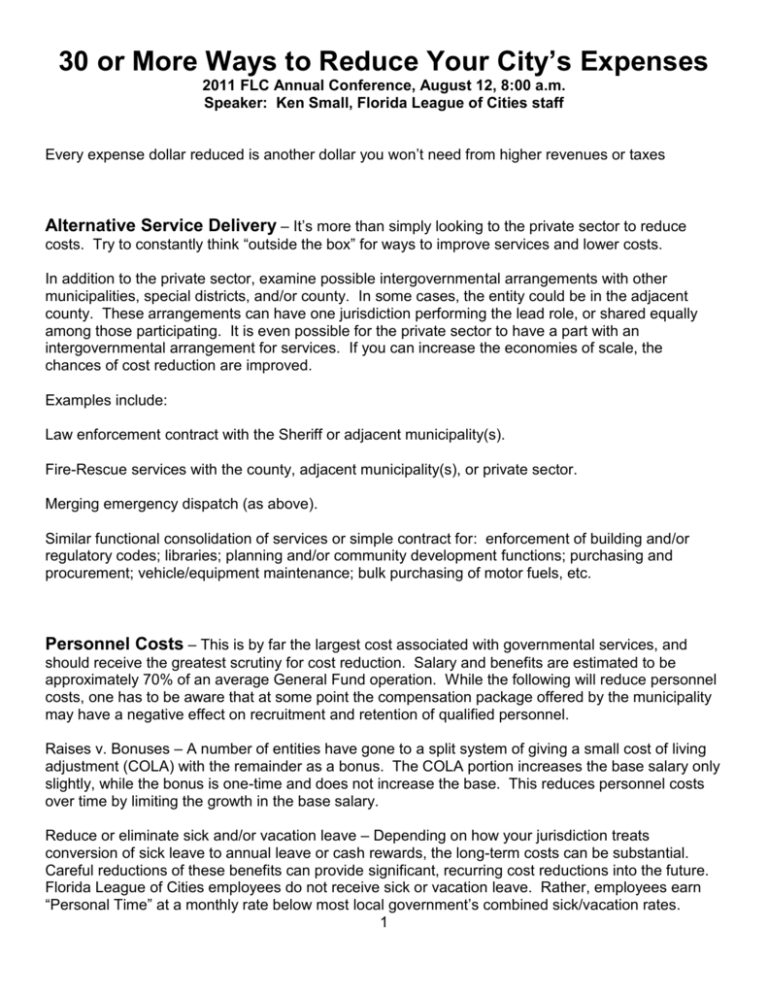
30 or More Ways to Reduce Your City’s Expenses 2011 FLC Annual Conference, August 12, 8:00 a.m. Speaker: Ken Small, Florida League of Cities staff Every expense dollar reduced is another dollar you won’t need from higher revenues or taxes Alternative Service Delivery – It’s more than simply looking to the private sector to reduce costs. Try to constantly think “outside the box” for ways to improve services and lower costs. In addition to the private sector, examine possible intergovernmental arrangements with other municipalities, special districts, and/or county. In some cases, the entity could be in the adjacent county. These arrangements can have one jurisdiction performing the lead role, or shared equally among those participating. It is even possible for the private sector to have a part with an intergovernmental arrangement for services. If you can increase the economies of scale, the chances of cost reduction are improved. Examples include: Law enforcement contract with the Sheriff or adjacent municipality(s). Fire-Rescue services with the county, adjacent municipality(s), or private sector. Merging emergency dispatch (as above). Similar functional consolidation of services or simple contract for: enforcement of building and/or regulatory codes; libraries; planning and/or community development functions; purchasing and procurement; vehicle/equipment maintenance; bulk purchasing of motor fuels, etc. Personnel Costs – This is by far the largest cost associated with governmental services, and should receive the greatest scrutiny for cost reduction. Salary and benefits are estimated to be approximately 70% of an average General Fund operation. While the following will reduce personnel costs, one has to be aware that at some point the compensation package offered by the municipality may have a negative effect on recruitment and retention of qualified personnel. Raises v. Bonuses – A number of entities have gone to a split system of giving a small cost of living adjustment (COLA) with the remainder as a bonus. The COLA portion increases the base salary only slightly, while the bonus is one-time and does not increase the base. This reduces personnel costs over time by limiting the growth in the base salary. Reduce or eliminate sick and/or vacation leave – Depending on how your jurisdiction treats conversion of sick leave to annual leave or cash rewards, the long-term costs can be substantial. Careful reductions of these benefits can provide significant, recurring cost reductions into the future. Florida League of Cities employees do not receive sick or vacation leave. Rather, employees earn “Personal Time” at a monthly rate below most local government’s combined sick/vacation rates. 1 Employees tend to be very careful when using leave – the abuse of just “calling in sick” in lieu of a vacation day is greatly reduced. Such leave can be capped at a couple hundred hours, with no cash conversions allowed. Once the cap is reached, it’s “take it or lose it.” A few jurisdictions copy the private sector in this benefit area. They provide a set number of weeks of vacation, and it totally disappears at the end of the year if not taken. This significantly limits payout liability when the employee leaves employment. Revise/reduce pension benefits for newly hired employees – Many governmental jurisdictions are readdressing future pension liabilities either through defined contribution plans, or less generous defined benefit plans. Selective Separation in Conjunction with Reorganization – Many jurisdictions instituted a “hiring freeze” early on in the economic slowdown. This allowed numerous positions to remain vacant in anticipation of significant position reductions as the dismal budget picture later revealed. It is always preferable to eliminate vacant positions than telling a valuable municipal family member their position is being eliminated. Occasionally, the reorganization will contain some necessary vacant position that a laid-off employee is eligible to assume, but that is usually very limited, due to the sheer number of position reductions in an economy as devastating as this. When such targeted positions contain current employees, many jurisdictions attempt to offer severance incentives. These incentives can include 3, 6, or possibly 9 months’ lump salary payouts, coupled with possibly 6-12 months paid health coverage. Most employees would rather come away with some compensation, than gamble with an out-and-out layoff with more limited severance. Voluntary Early Retirement – Some jurisdictions have found ways to offer compensation packages to long-term employees who haven’t reached retirement thresholds, or have reached retirement age and have chosen to continue growing retirement benefits. In the former option, the Plan would need to be amended if that provision is not specified; while in the latter, it would require some amount of additional compensation to entice them to retire early. As with each of the employee reduction methods discussed above, the net effect is to make large reductions in personnel staffing to significantly reduce future costs. While there are numerous positive benefits from these actions, there are negative impacts associated with these methods. These are reductions in services and/or service levels, and the loss of “institutional knowledge” within the organization. This knowledge has a high value in any organization! As always, legal considerations are very important whenever dealing in this environment. Considerations include: collective bargaining agreements, Fair Labor Law issues, age discrimination and minority issues. Eliminating or Significant Reductions in Utility Payment Collections – More and more jurisdictions with utility operations have begun to radically reduce payment collections by municipal employees, and are successfully utilizing the private sector. Private sector entities, such as banks, credit unions, and grocery stores, have the tools and employees already in place, so the economies of scale can benefit both of you. Approach these and other sectors to discuss possible contract terms. Most grocery stores now have banking and other transaction facilities, and would welcome an opportunity to increase foot-traffic into their stores – the same goes for banking institutions. When a municipal utility office location is eliminated, not only the obvious personnel costs are reduced, but security costs associated with it are also eliminated. The former office space can also be utilized in other productive ways. 2 Strategic, or Surgical, Downsizing of Your Workforce – The following is one real example of systematically reducing one’s workforce without attempting to affect one’s level of service. Once the issue of what services will be provided, and the level or frequency has been determined, a careful analysis of your workforce can provide many surprises and ways to lower costs. Over years, employees can often pick up tasks and duties that are no longer necessary, or that no one even understands why they are being performed. Many organizations take it for granted that lower management within individual departments are fully knowledgeable of all that occurs under them – that is not always the case. Most of the time, they are so busy with the “crisis of the hour” that they never have the time to really examine the specific day-to-day tasks of their employees. The person or persons chosen to perform the analysis should have a good understanding of the functions being examined, as well as a good understanding of the mission of the current administration and top management. It is important that he/she/they not have a bias toward maintaining the department’s “fiefdom.” Likewise, this is not the time to try to use an intern. To do this, it is necessary to identify each employee’s actual routine of tasks that they perform throughout the year in order to determine which ones are relevant to your current mission, and which ones should be eliminated. One easy way to accomplish this is to have each relevant employee spend two monthly cycles (60 days) jotting down each task as they are performing it, both big and small, over this time period. Once complete, the analyst should sit down with each employee, and work their way through the various tasks to gain a good understanding of the relevant tasks and processes that each employee performs. When the analyst identifies tasks that are not readily understood by the employee or the analyst believes that it may not be necessary, use probing questions such as: Why is this performed? How did this start? Who is it performed for? If an answer is not sure to why or how, it probably requires additional scrutiny. Once this process is complete, the analyst should go back to management to determine which tasks should be eliminated or modified. For those tasks found to be necessary under the current mission of the municipality, management can determine if any fine-tuning is necessary, such as frequency needs to be modified, or if there is a more efficient or effective way to accomplish it. As unnecessary tasks and workloads are reduced with each employee, this allows these employees to take on more important duties, or gradually eliminate positions as employee turnover occurs. An analysis such as this cannot be completed in a short time period, but rather can be accomplished over a year or more, depending on availability of these key staff members. The simple task of just questioning employees about how and why they perform tasks and duties can give positive results. Such examinations at this level will almost always find improvements for greater efficiencies, including the elimination of unnecessary work. Energy Costs – Energy is another significant cost area associated with municipal operations, and one that can be contained and/or reduced with careful analysis and evaluation. In the past year, most county school districts have undergone rigorous energy analyses, and have saved millions of dollars in future costs. Ask to review your local district’s recommendations and findings. Contact your energy providers for free or subsidized energy audits. Upfront, discuss what their processes entail to see if it is as thorough as you would wish. If not satisfied with their service, request that they suggest reputable private energy analysis firms in your region that may be able to provide a very thorough analysis. Energy costs today are much higher than they were only a few years ago, so energy audits conducted today or in the near future may reveal greater cost-efficiencies with much shorter pay-back periods. As you may have seen, any indication that the economy may be showing signs of recovery 3 has spiked future energy costs among Wall Street traders. This only means that future energy costs will be much greater in an improving world economy. Below are a few options to reduce energy costs: Conduct a Comprehensive Fleet Analysis – Any type of analysis beyond the current status quo is positive. Simply asking probing questions into how and why vehicles and equipment is chosen, and who eventually uses it, is a good start. More comprehensive reviews include examining and reducing take-home privileges, downsizing vehicles to smaller and more energy-efficient models, and reducing the size of the fleet. Some jurisdictions have eliminated take-home vehicles to many staff members, and replaced it with a reasonable vehicle allowance. Others have a few pool vehicles available, and require the use of these over payment of personal mileage reimbursement which at today’s mileage rates can add up quickly. On short-term, out-of-town travel, look at a car rental under the State of Florida contract (Avis) – such costs, including fuel, run approximately 20-22 cents per mile, compared to the State mileage rate at of 44.5 cents per mile, and even higher under IRS rules. Major Usage Replacements – New technologies are being developed constantly, and equipment that is only 5-10 years old may have very short pay-back periods when replaced. This includes lighting and heating/cooling systems, among others. Don’t forget to look at your utility operations – these have tremendous energy consumption levels, and the use of an experienced electrical engineer to document equipment replacements and energy savings can be extremely beneficial to your energy bottom-line! Vampire Electronics – The term, "vampire power,” means the electricity your electronic appliances and electronics suck out of the power grid when you're not using them. All such devices have the potential to be vampire devices if they consume extra electricity while in standby mode. Many appliances need power to keep their electronic key pads ready to go, even when they look completely off. Exact figures on total losses to standby power are not available, but a recent major survey on the subject estimated that in the United States, 5% of electricity usage is due to standby power. Depending on the efficiency of your unit's design, the standby power use can be minimal or substantial. A simple calibrated watt meter can be fairly inexpensive, and can quickly identify which pieces of equipment consume the most in standby mode. A surge protector with a simple on-off switch can handle several applicable appliances. Not all equipment should be completely removed from electricity, so have your technology expert assist with the identification of the consumption culprits. Global Positioning System (GPS) Tracking Devices in Vehicles – These can do wonders at reducing fuel consumption and unnecessary mileage, and increase productivity! Once your workforce knows management can track travel locations, date/time, speed, and unnecessary idling of each vehicle, use patterns will change dramatically. It’s like having the boss in the back seat, without being there! The prices of such devices have been dramatically reduced, and can pay for themselves quite quickly. Tankless Water Heaters – When smaller amounts of hot water are needed, or when very hot temperatures are not necessary, Tankless Water Heaters are an option. They heat water directly without the use of a storage tank. Therefore, they avoid the standby heat losses associated with storage water heaters. When a hot water tap is turned on, cold water travels through a pipe into the unit. In an electric unit, an electric element heats the water. In a gas-fired unit, a gas burner heats the water. As a result, Tankless Water Heaters deliver a constant supply of hot water, and use far less energy. Another option is to identify areas that currently have hot water where it is not absolutely needed. In those cases, simply disconnect the power to the unnecessary hot water heaters. 4 Communication Costs – It appears that the use of wireless electronic devices (cell phones, smart phones, etc) has grown dramatically, and has increased productivity, but so has the cost. Some jurisdictions have found that costs can be reduced by paying employees an allowance to use their personal devices, rather than supplying them under the municipality’s service contract. This is done in a similar manner as a car allowance. Another viable way to reduce costs is to conduct an analysis and audit of all telecommunication voice, data, internet and long distance services, and billing. Unlike energy providers, who have it in their financial interest to assist their customers to lower usage in order not to have to build additional, expensive generating capacity, telecommunication companies enjoy greater profits when customers overpay for services. It is for this reason that a self-audit by your service providers is not in your best interest. With such a service, cost reductions normally come from the following sources: Billing errors: Past erroneous charges can lead to refunds or billing adjustments. Unclaimed exemptions: The City may be improperly charged for taxes from which it is exempt. Over provisioning: An in-depth review of your network may lead to the discovery of unnecessary and costly services that can be eliminated without affecting your service. Less-than-optimum rates: You may be able to pay less for the same, or a substantially similar service. Less-than-optimum facilities: You may be able to accomplish the same task using different, but less costly techniques. The Florida League of Cities provides this service specifically for its membership with costs based entirely on a contingency fee basis. That means if no refunds are secured, and/or if no cost reductions are produced, there is no cost at all. For additional information on this program, contact Ken Small at Ksmall@flcities.com. Health and Safety – One of the best ways to reduce group health insurance costs is to convince your employees to live a more healthy life. Finding a way to do so is easier said than done! Each year, more than 40% of premature deaths in the United States result from unhealthy behaviors such as smoking, over-eating or failing to take medications as prescribed. Physicians routinely struggle to get patients to give up their bad habits for the sake of their long-term health, yet 20% of Americans still smoke, and 71% are either overweight or obese. It should not be about going on a diet; it is about changing behavior to live a healthy life. The negative words (diet) are being replaced with a commitment to healthy living. To do so requires “behavior modification,” and the savings can be substantial. The use of financial incentives, for as little as $3.00 a day, has been found to motivate healthy behavior. Well-designed wellness programs can result in an average 25-percent reduction in healthplan costs, sick leave, disability costs, and workers’ compensation. Some jurisdictions have established weekly clinics that utilize a doctor and nurses to treat less-serious routine illnesses and symptoms for employees and family members, thus reducing higher costs associated with private 5 doctor offices. The City of Lakeland’s wellness clinic requires workers to go through a comprehensive assessment that includes testing for blood sugar and cholesterol, then a "body mass" evaluation, which has everything to do with fat. This information allows them to begin working with the employee to get his/her life under control. Clinics such as these can be contracted with local health providers and/or shared with other jurisdictions and/or local businesses. We are beginning to see local governments add “surcharges” to employees who continue with bad behavior, such as smoking and/or obesity issues. The employee can have the surcharge removed once the unhealthy behavior has been eliminated. Orange County commissioners recently voted on a surcharge on health insurance for County employees. Employees who smoke would have to pay up to $25 per pay period under the proposal. The money, according to County officials, would go to offsetting medical insurance hikes. The County’s insurance plan includes information on medicallybacked ways to drop the habit. For a comprehensive listing of free worksite wellness programs and wellness resources, go to the following website: http://www.infinitewellnesssolutions.com/free_wellness.htm. Or, go to the CDC’s website on obesity: http://www.cdc.gov/obesity/index.html Just as wellness programs work to reduce long-term health costs, a “safety program” is a primary way to reduce Workers Compensation (W/C) costs. W/C costs are basically calculated between “risk” and your municipality’s experience factors. Each type of occupation is assigned a risk classification. Risk is determined by two factors: the frequency of on-the-job injury and the severity of injury. Severity is measured by both medical payments and indemnity benefits (payments made directly to the injured employee to compensate for losses suffered as a result of an accident). The “experience factor” is based on your safety history. Workers' compensation insurance carriers can reduce or increase base rates based on a number of factors. The most important factor is the employer's safety history. This is why you should make safety such an important issue among your employees. To get more information on improving safety in your workplaces, contact your insurance provider. Seminars, onsite inspections/safety audits, employee training specific to exposure concerns, as well as other entity-specific safety support are commonly available from your insurance carrier. The Florida League of Cities, through the Florida Municipal Insurance Trust, takes safety very seriously, and has many programs to assist in reducing your League W/C premiums. Solid Waste Collection – Without getting into the debate whether you should utilize municipal employees or private sector contractors to collect solid waste, the issue of weekly collection frequency is a very important cost consideration. The standard collection frequency in Florida appears to be twice-weekly for garbage, though a couple of jurisdictions provide more. By reducing garbage collection to once weekly, substantial savings can be achieved. Surplus Equipment - Through a special arrangement with GovDeals, Inc., the League provides an Internet-based auction to Florida local governments for their surplus equipment. We encourage you to visit www.govdeals.com to view the actual auctions currently underway. This is a “no up-front cost” arrangement. You pay nothing to start the service and only pay a percent of the sales price of what is sold (typically a much lower percent that an auctioneer will charge). Local governments have the freedom to withdraw a product from sale at any time, or to reject all bids without paying a fee or penalty. 6 Opportunity Costs for Investments – This is sort of like losing money, when you could be making more. Currently, returns on short-term investments are quite low - low enough that the opportunity costs of not considering other investment options may be significant. Since many municipal investment policies require an emphasis on safety, liquidity and yield (and in that order), many local governments assume these requirements limit them to investing only in money markets, Certificates of Deposit, or insured bank accounts. Other options are available that may be able to increase returns, while still providing safety and liquidity. The Florida Municipal Investment Trust offers three high-quality bond funds available to municipalities that go beyond what money markets or your local bank has to offer. 7
